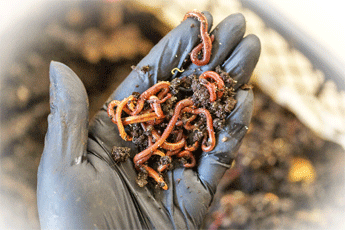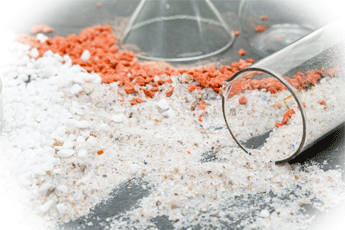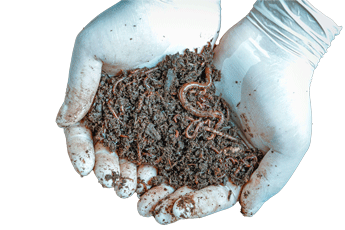 Seed starting with worm castings
Seed starting with worm castings
In my latest series of posts on growing Chillies, I took an in-depth look into the finer details of starting seeds. I covered all aspects, from seed selection through to the first potting on. However, I only touched on the use of fertilisers. It is a base I thought I already had covered. After all, Chilli seedlings don’t need fertilisers until much later. They first need to develop their first set of true leaves . When this happens, the seedlings are potted on. It is only at this stage that nutrients need to be considered.
. When this happens, the seedlings are potted on. It is only at this stage that nutrients need to be considered.
It was to my surprise that after researching worm castings, I discovered there may be a better way to do things. It seems worm castings have a fantastic role in seed starting. This is what I learned.
Worm castings are essentially “worm poo”, for the want of a better way of describing them. They are a fertiliser made by feeding waste vegetables and animal products to worms. The worms eat these waste products; it passes through their digestive systems, and you are left with castings.
The conventional wisdom is that seedlings have enough nutrients to carry them through to their first set of true leaves. They don’t need any additional nutrients before then. So, if that is the case, why would anyone want to change? The truth is, what I discovered made total sense to me. It seemed like I had found new ground, and it was something I just had to try. Here’s why.
What fertilizer do seedlings need?
Nitrogen, phosphorous & potash
The nutritional requirements of plants are always described by suppliers of fertiliser at a base level element in terms of an NPK. NPK is an abbreviation of nitrogen, phosphorus, and potassium. The nitrogen element promotes healthy bush growth, while phosphorous and potassium enhance root formation, flowering, and fruit set.
When a plant is young, you will want to feed it with a fertiliser rich in nitrogen to promote healthy growth. Once this is achieved, nitrogen starts getting cut back in favour of phosphorus and potassium to achieve other objectives.
Now here’s the thing. Worm castings have an NPK of only 1: 0: 0, whereas in a fertilizer like Chilli Focus, the NPK is 2.7: 1: 4.4. So, why use it all? The answer is, in starting seeds, the objective of using worm castings is not what nutrition it can provide, but for its other qualities.
The first advantage is that worm castings can provide good aeration to the roots of the plant once the seed has germinated. Secondly, it is a good way to ensure moisture retention. It is spongy and can absorb water in just the right proportion for healthy seedling growth. But surely you can achieve the same using vermiculite, you may ask? Yup, for sure, but it doesn’t end there. It seems that worm casings can help plants fight off pathogens like Pythium. Pythium is one of the pathogens that causes damping off if a seedling is given too much water.
My research also suggests that worm castings can repel pests like aphids, by something called Chitinase. Chitinase is an enzyme present in worm casings that breaks down chitin (a type of glucose) in the backbone of insects’ exoskeletons. This reaction can lead to 40 percent less hard-shelled pests.
Based on these two claims. I am sold, I must give it a bash. My next batch of seed-starting compost will definitely contain worm castings. But that’s not all said and done about worm castings. While it might be called a fertiliser, with such a low NPK count, is it one at all? Turns out, worm castings should probably be rather be referred to as a fertiliser enhancer. What they do is make fertiliser added to the soil more accessible to the roots of the plant, rather than providing the nourishment itself.
The fertilisers that we give to plants might have impressive labels stating the nitrogen level is this, and the potassium level is that, etc. It all sounds good. The problem is that plants don’t have the ability to absorb all these nutrients. It’s all a bit hit and miss. But this is where beneficial microbes in the worm castings step up to the plate. They can turn these elements into nutrients that the plant can more absorb more easily.
While not part of the scope of this discussion, this quality will be fantastic to exploit once Chilli seedlings step beyond being young plants and start needing more extensive fertilisation.
Finally
I find this fascinating. One thing I know is it is not good to over-fertilise seedlings. It is not good for them. Full stop. However, if I can give my seedlings an extra layer of protection, it is certainly something I am prepared to do. I can’t see a risk of overfeeding the seedlings (link refers to tomatoes, but the same principles apply) due to the low NPK of worm castings. I can only see pluses.
In my next post, I will cover a new starting mix, partly made with worm castings I will be trying out. The make up of this new starting mix will also need to consider other factors. One of these is that it will not contain any peat at all. This is part of my drive to become peat free in my Chilli growing.
Let’s see how it goes!



